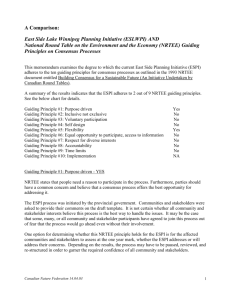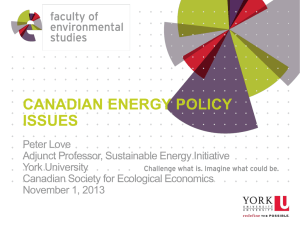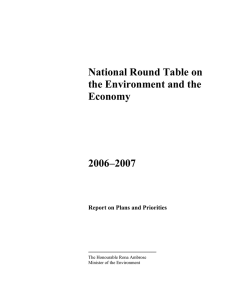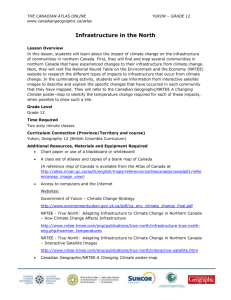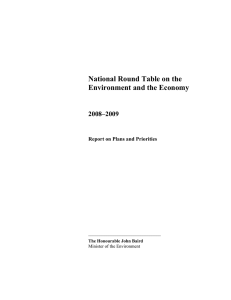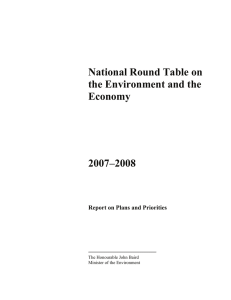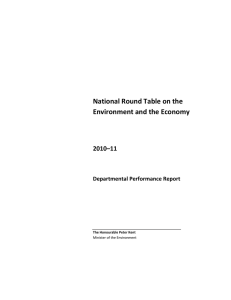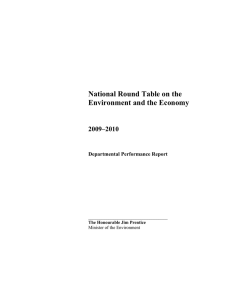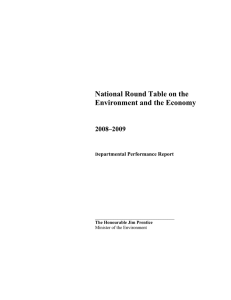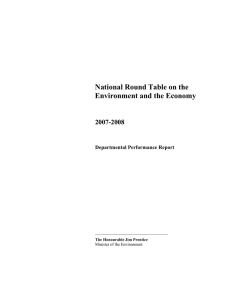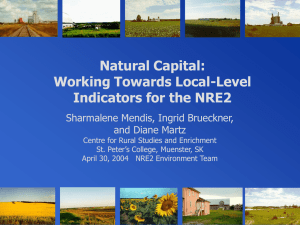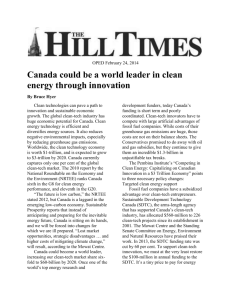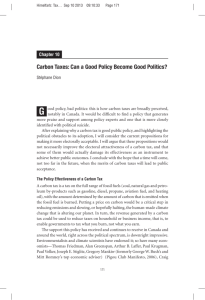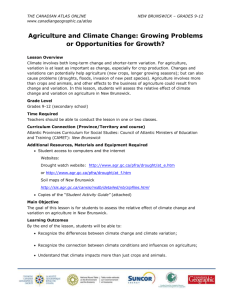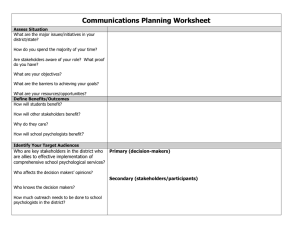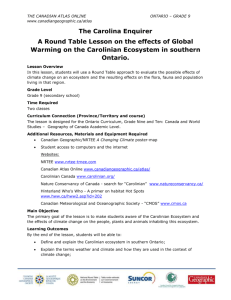National Round Table on the Environment and the Economy 2006-2007
advertisement
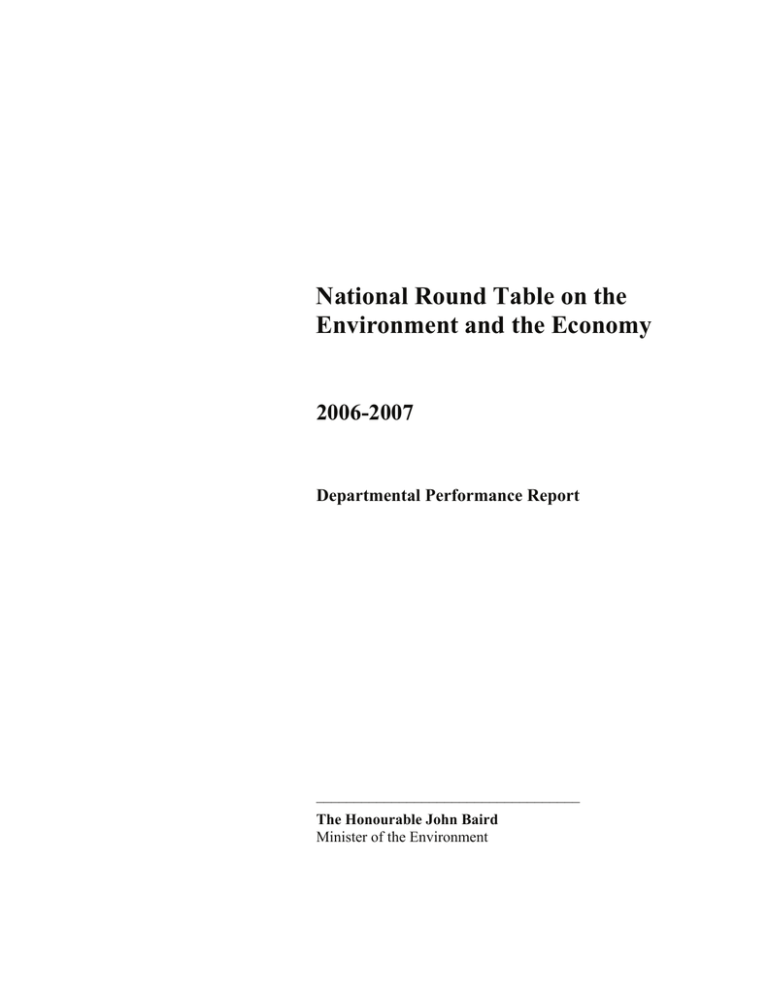
National Round Table on the Environment and the Economy 2006-2007 Departmental Performance Report ___________________________________ The Honourable John Baird Minister of the Environment Table of Contents Message from the President ............................................................................................. 1 Section 1 Overview ........................................................................................................ 3 1.1 Management Representation Statement............................................................ 3 1.2 The NRTEE Program Activity Architecture (PAA)......................................... 4 1.3 Performance Measurement: A New Approach for the NRTEE........................ 5 1.4 Summary Information....................................................................................... 6 1.4.1 Performance Results by Priorities: Summary ............................................. 7 1.5 Operating Environment and Context ................................................................ 9 1.6 Alignment with the Government of Canada Outcome Areas ......................... 10 1.7 Achieving the NRTEE’s Strategic Outcome: Overall Progress ..................... 10 1.8 Summary of Performance Results by Indicator .............................................. 11 Section 2 Analysis of Program Activity by Strategic Outcome............................... 12 2.1 Departmental Priorities ................................................................................... 12 2.2 Performance Results by Program Activity ..................................................... 12 2.2.1 Expected Result: High-Quality Research ................................................. 12 2.2.2 Expected Result: Effective Stakeholder Consultations............................. 15 2.2.3 Expected Result: Useful Recommendations and Advice.......................... 17 2.2.4 Expected Result: Effective Communication of NRTEE Recommendations....................................................................... 20 2.2.5 Expected Result: Increased Awareness and Understanding by Federal Decision Makers and National Stakeholders ............................... 23 2.3 Summary of Performance Assessment by Indicator......................................... 24 Section 3 Supplementary Information ...................................................................... 28 3.1 Organizational Information and Organization Chart ........................................ 28 3.2 Financial Tables ................................................................................................ 29 Section 4 Other Items of Interest ............................................................................... 32 4.1 NRTEE Stakeholders ........................................................................................ 32 4.2 The NRTEE Performance Measurement Framework....................................... 33 4.3 NRTEE Members.............................................................................................. 34 4.4 NRTEE Contact Information ............................................................................ 36 Message from the President I am pleased to present the Performance Report of the National Round Table on the Environment and the Economy (NRTEE or Round Table) for the fiscal year that ended March 31, 2007. Created by the Prime Minister in 1988 as an independent advisory body reporting to the federal government, the NRTEE had its status formalized in a 1993 Act of Parliament. The purpose of the Round Table, according to the Act, is “to play the role of catalyst in identifying, explaining and promoting, in all sectors of Canadian society and in all regions of Canada, principles and practices of sustainable development.” The NRTEE draws on the insight and experience of its members to examine the environmental and economic implications of priority issues and offer independent advice on how to address them. Appointed by the government, its members represent different regions of Canada and are distinguished leaders in business, labour, universities, environmental organizations, Aboriginal communities, and municipalities. (See a list of members in Section 4.) NRTEE activities align with the government’s objective of building a strong, globally competitive, sustainable, technologically innovative economy. The NRTEE reports to the Minister of the Environment, but as an independent national body, it shares advice with other levels of government and various non-government sectors. The agency strives to influence federal policy development on environment and economy issues. To accomplish this, it must produce and disseminate relevant, credible advice in a timely manner. In 2006–2007 the NRTEE delivered effectively on the commitments made in its Report on Plans and Priorities (RPP) in the identified priority areas. After releasing findings and advice to the government on a long-term climate change and energy strategy (the “Wedge Report”) in June 2006, the agency embarked on a successful outreach initiative and consulted online to promote awareness of and gather feedback on this advice. Also in the reporting period, the Round Table responded to a reference from the government to provide advice on specific elements of Canada’s proposed Clean Air Act. This work will be completed in the fall of 2007. In parallel with this work, and in partnership with other organizations, the NRTEE continues to examine how Canadians can adapt to climate change, particularly as it affects the vulnerable northern parts of our country. In February 2007, the NRTEE released a State-of-the-Debate Report entitled Capital Markets and Sustainability: Investing in a Sustainable Future. The report was well received in the financial sector. To improve its overall ability to influence policy development, the NRTEE initiated a review of how it communicates with stakeholders and sought advice on how to be more effective in this area. The Round Table will consider the recommendations from this review in 2007–2008. On the operations side, the Round Table continued to strengthen its accountability and management systems. Senior staff were trained on delegation of authorities; the agency Message from the President and CEO Page 1 completed a MAF self-assessment, with satisfactory results; it laid the groundwork for implementing an electronic system to improve how it manages information; and it worked to comply with Treasury Board Secretariat’s requirements under the Management Resources and Results Structure (MRRS). Addressing what had been previously identified as a weakness in terms of corporate evaluation, the NRTEE developed a new performance measurement framework designed to generate improved performance information for decision making and for external public reporting. Moreover, it will allow the Round Table to measure its overall corporate performance efficiently and consistently over time. Results of the first round of performance measurement activities for 2007–2008 are included in this report. The Round Table plans to build on the positive results achieved in 2006–2007, providing the credible and independent research and advice on which it has built its reputation. David McLaughlin President and CEO Message from the President and CEO Page 2 Section 1 Overview 1.1 Management Representation Statement I submit for tabling in Parliament, the 2006–2007 Departmental Performance Report for the NATIONAL ROUND TABLE ON THE ENVIRONMENT AND THE ECONOMY (NRTEE). This document has been prepared based on the reporting principles contained in the Guide to the Preparation of Part III of the 2006–2007 Estimates: Reports on Plans and Priorities and Departmental Performance Reports: It adheres to the specific reporting requirements outlined in the Treasury Board Secretariat guidance; It is based on the agency’s approved Strategic Outcome(s) and Program Activity Architecture that were approved by the Treasury Board; It presents consistent, comprehensive, balanced, and reliable information; It provides a basis of accountability for the results achieved with the resources and authorities entrusted to it; and It reports finances based on approved numbers from the Estimates and the Public Accounts of Canada. David McLaughlin President and Chief Executive Officer Section 1: Overview Page 3 1.2 The NRTEE Program Activity Architecture (PAA) The NRTEE is presenting this performance report using the Treasury Board-approved PAA shown in Figure 1 below. This aligns with the PAA used in the 2006–2007 Report on Plans and Priorities (RPP), which indicates that the NRTEE worked toward a single strategic outcome and was engaged in a single program activity. However, for this Departmental Performance Report (DPR), consistent with minor changes recently approved by the Treasury Board Secretariat (TBS), the NRTEE will report only on this program activity, rather than to the sub-activity level.1 Figure 1: Program Activity Architecture National Round Table on the Environment and the Economy Strategic Outcome Federal policy development on environment and economy issues and decisions in other key sectors are influenced by NRTEE advice on selected issues Program Activity Provide advice on environment and economy issues (Planned spending 2007–2008: $5.156m) Subactivities 1 Produce Advice: Identify new knowledge Convene and consult stakeholders Promote Advice: Advise federal clients Promote to other key sectors In June 2007 the TBS approved minor changes to the NRTEE’s PAA as part of its initiative to update its Management Resources and Results Structure (MRRS). These changes did not result in any changes in direction or any resource reallocation for the Round Table, and will be fully adopted for reporting purposes in 2007–2008. Section 1: Overview Page 4 1.3 Performance Measurement: A New Approach for the NRTEE In 2006–2007, the NRTEE initiated a more rigorous approach to measuring its performance. The objective was to produce evidence-based performance information for decision making and improve external public reporting in the DPR. For this DPR, the NRTEE’s performance was assessed against the expected results and indicators shown below. Expected Result Performance Indicator High quality research Perceived quality of research Effective consultations Extent of consultations Effectiveness of consultations Useful recommendations and results Perceived usefulness Perceived independence of NRTEE Demand for NRTEE advice Effective communication of recommendations Reach of recommendations Increased awareness and understanding of issues and solutions Awareness of issues and solutions Quality of communications Understanding of issues and solutions A key preliminary data source for this reporting period was a recent survey of some federal decision makers (via in-person interviews) conducted on behalf of the NRTEE in May-June 2007 (“the NRTEE survey”).2 Although not referring specifically to the 20062007 period, preliminary findings are included in this DPR to assist in reporting on the agency’s performance. Over the course of 2007-2008, the Round Table will give due consideration to these findings, their context, and their potential implications for future NRTEE plans and activities. Other data sources were as follows: • Feedback provided by participants after NRTEE consultation sessions (by completion of a questionnaire); and • Operational data related to the research programs, communications, and overall management of the NRTEE. 2 The survey was conducted by Marbek Resource Consultants. Results are taken from an Interim Report: Results of Survey of Federal Decision makers, August 9, 2007. Section 1: Overview Page 5 1.4 Summary Information Reason for Existence: The purpose of the Round Table is to play the role of catalyst in identifying, explaining and promoting, in all sectors of Canadian society and in all regions of Canada, principles and practices of sustainable development. The agency interprets this broad mandate through a strategic focus on issues of national interest at the intersection of the environment and the economy. Through its work, the NRTEE identifies and promotes ways to encourage economic prosperity for all Canadians while striving to preserve the environment for current and future generations.3 Financial Resources ($000s) 2006–2007 Planned Spending Total Authorities Actual Spending $5,183 $5,292.4 $4,535.2 Human Resources 2006–2007 3 Planned Actual Difference 25 23 2 General information about the NRTEE and its membership can be found on the agency’s website at www.nrtee-trnee.ca. Section 1: Overview Page 6 Status on Performance 2006–2007 (in $000s) Status on Performance Planned Spending Actual Spending Strategic Outcome (from RPP 2006–2007): Federal policy development on environment and economy issues, and decisions in other key sectors, are influenced by NRTEE advice on selected issues. Priority No. 1: Provide advice to decision makers on environment and economy issues of national importance Produce advice through research and stakeholder consultation, and promote advice to federal clients and other sectors. Expected Result: Federal clients and national stakeholders are aware of and understand the problems, opportunities, and practical solutions identified and examined by the NRTEE. Successfully met $4,933.0 $4,387.2 Priority No. 2: Strengthen management accountability and systems and implement new federal initiatives The NRTEE will enhance its systems for information and records management, continue its efforts relating to Content Management Solutions, initiate a MAF self-assessment, strengthen its procurement and HR policies and update its approach to evaluating its performance. Expected Result: The NRTEE moves closer to fully implementing these initiatives Successfully met $250.0 $148.0 1.4.1 Performance Results by Priorities: Summary In the RPP for 2006–2007, the NRTEE identified two priorities. The performance results for each are summarized below. Priority 1: Provide advice on environment and economy issues of national relevance As planned, the NRTEE developed policy advice in 2006–2007 related to energy and climate change, and advanced its work on policies for adaptation to climate change. In addition, the Minister of the Environment requested the NRTEE to provide advice to the Section 1: Overview Page 7 Government of Canada on air pollutants and greenhouse gas emissions in support of the Canada’s proposed Clean Air Regulatory Agenda. The Round Table commissioned five studies to further its work in this area. Following the release of its Advice on a Long-term Strategy on Energy and Climate Change for Canada in June 2006, the NRTEE embarked on a major in-person and an online outreach initiative to promote awareness of and gather feedback on the advice. In February 2007, the Round Table also released its State of the Debate Report on Capital Markets and Sustainability at the Toronto Stock Exchange. As specified in its RPP, the agency will have succeeded when decision makers report that the NRTEE has given them a new way of viewing issues and has raised their awareness and understanding of the issues. Feedback from federal decision makers surveyed includes the following: • There is a continuing high regard for the quality of research carried out by NRTEE. • The scope and effectiveness of consultations carried out by NRTEE are broadly recognized, both at a national level and within specific research programs. Some noted that NRTEE may in some cases have focused too much on information dissemination rather than consultation and dialogue. • NRTEE policy analysis is relevant, timely, and useful. • NRTEE advice and recommendations are considered when assessing policy options. • NRTEE communications could expand their reach across a broader range of federal decision makers. • The NRTEE must maintain an appropriate balance between researching policy (i.e., “content creation role”) and fostering dialogue and the exchange of information and best practices (i.e., “process facilitation role”). Priority 2: Strengthen management accountability and systems, and implement new federal initiatives Even with limited staff and a small budget, the agency takes seriously its responsibility to ensure that the stewardship of its financial and human resources is effective and aligned with government-wide initiatives. In 2006–2007, the NRTEE established several areas of focus to improve its management practices. The single performance indicator noted in the RPP 2006–2007 was “compliance with government requirements.” In each instance, the NRTEE has met or exceeded requirements. • Management of Government Information: In 2006–2007, the NRTEE completed its Information Management Policy. The agency embarked on a major project to implement the Records, Document and Information Management System (RDIMS), completing a pilot application and beginning the rollout of training Section 1: Overview Page 8 and implementation by all staff by the summer of 2007. The RDIMS project will enable the agency to organize and control all corporate documents and records so as to ensure information is archived appropriately and is available when needed. It also facilitates the agency’s compliance with government legislation and policy related to information management and expedites responses to Access to Information requests. • Government of Canada Content Management Solution (CMS): The NRTEE completed the first phase of a CMS project that incorporates the Government of Canada’s CMS approach, lessons learned, stakeholder engagement strategies, and common standards for integrated government information and service delivery. Several key software products were configured in accordance with the NRTEE’s internal requirements and Government of Canada standards. • NRTEE Secretariat Management Committee: A permanent mandate was established for the committee of senior managers, who meet bi-weekly to oversee the planning and management of the agency’s financial, information, and human resources. • Management Accountability Framework (MAF): The NRTEE participated for the first time in the MAF process. The agency was able to demonstrate that it has a strong (if somewhat less formal) approach to management. Of the 12 indicators in which the NRTEE was rated, it received 10 “acceptable” ratings, two “opportunity for improvement” ratings, and no “attention required” ratings. • Procurement and Contracting: Oversight of this area was significantly strengthened by the establishment of a central tracking system for contracts, review of contracts and procurement expenditures over $10,000 by the Management Committee, and training of key staff responsible for these areas. • Human Resources (HR) Management: In 2006, the NRTEE established a set of core HR values in consultation with all staff. Based on those values, the agency also put in place staffing and training and development policies. • Risk Profile: The NRTEE updated its risk profile. 1.5 Operating Environment and Context The NRTEE’s success depends on its ability to influence federal policy on environment and economy issues. To accomplish this, the NRTEE must produce and promote relevant, neutral, credible advice in a timely manner. Its ability to do so is affected by a range of internal and external factors. Those relevant in 2006–2007 are discussed below. Internal operating factors Requests from the government to provide specific kinds of advice can create challenges in terms of the organization’s ability to plan from year to year. The timing of such references cannot be controlled and the agency is often expected to identify the necessary resources from within its own budget. In 2006, resources were set aside early in the year to address an anticipated request, but confirmation and details of the advice required did not arrive until November. The result was the eventual lapse of operating funds. (See Section 3, Table 1.) Section 1: Overview Page 9 External factors In Canada, particularly for the issues typically examined by the NRTEE, policies are not developed in isolation—the government’s associations with the provinces, municipalities, and even other countries can affect them. This creates a complex decision-making environment that can potentially compromise the federal government’s ability to act on the NRTEE’s recommendations. The NRTEE also competes for attention within the array of priorities being addressed by key stakeholders. This is a significant and ongoing challenge that the NRTEE works to address through strategic communications efforts. 1.6 Alignment with the Government of Canada Outcome Areas The NRTEE’s work is relevant to several of the Government of Canada’s outcome areas, but aligns most directly with the strong economic growth outcome as shown below. Strategic Outcome Program Activity Federal policy development on Provide advice on environment and economy issues, environment and economy and decisions in other key sectors, issues are influenced by NRTEE advice on selected issues Link to Government of Canada Outcome area Strong economic growth In 2006–2007, the NRTEE contributed to this outcome primarily through its work and resulting advice on energy and climate change and how Canada can address this issue in the medium and long term. This advice, if implemented, is consistent with Canada’s national interest and the government’s objective of building a globally competitive, sustainable, technologically innovative economy that benefits all Canadians. 1.7 Achieving the NRTEE’s Strategic Outcome: Overall Progress Strategic Outcome: Federal policy development on environment and economy issues and decisions in other key sectors are influenced by NRTEE advice on selected issues. The NRTEE’s approach to achieving its strategic outcome is to produce policy advice and disseminate it so as to increase the understanding of decision makers about challenges and opportunities at the interface between the environment and the economy, and to inform the debate on those questions. An indicator of NRTEE performance in achieving this strategic outcome is the extent to which NRTEE advice is considered in federal policy decisions. Findings from the NRTEE survey show a range of opinions, from “advice is partly responsible for a number of policy decisions” to “advice is nearly always considered in assessing policy choices, even if specific recommendations are not necessarily pursued.” Section 1: Overview Page 10 1.8 Summary of Performance Results by Indicator Figure 2—Summary of performance results—Fiscal Year 2006–2007 Expected Results and Outputs Performance Indicator Performance assessment Performance level High quality research Perceived quality At target Effective consultations Extent of consultations Well perceived High quality analysis Comprehensive Broad consultations on Long-term Energy and Climate Change Extensive expert consultation High added value Good process Involve small groups Online consultation well perceived Useful and timely Relevant Risk of focusing too much on short term Sometimes overtaken by events Need to clarify research versus process role Some concern about long-term loss of independence given increased focus on federal government Continuing requests from federal government Strong demand for briefings from federal department and national stakeholders Citations from stakeholders Extensive data base Increasing media coverage Steady increase in use of website Reach could be increased Good mix of instruments Products are well perceived Limited impact on increasing awareness at federal level Unknown in case of national stakeholders Strong benefit in terms of greater understanding of issues Effectiveness of consultations Useful recommendations and advice Perceived usefulness, relevance and timeliness Perceived independence of NRTEE Demand for NRTEE advice Effective communication of recommendations Increased awareness and understanding of issues and solutions Reach of communications Quality of communications Awareness of issues and solutions Understanding of issues and solutions Section 1: Overview At target At target Approaching target Approaching target Page 11 Section 2 Analysis of Program Activity by Strategic Outcome 2.1 Departmental Priorities Name Type Priority #1: Provide advice on environment and economy issues Ongoing Priority #2: Apply sound management principles in operations, and implement federal initiatives Previously committed to/ Ongoing 2.2 Performance Results by Program Activity The text that follows provides an overall description of the performance results achieved by the NRTEE, as well as highlights of performance achieved under each result and performance indicator specified in the performance measurement framework. (Please see Section 2.3, Figure 12.) The results all apply to the agency’s single program activity, namely provide advice on environment and economy issues, which in turn support both of the priorities identified for the period. The results will be presented in accordance with the strategic outcome and indicators in the NRTEE’s new performance measurement framework. 2.2.1 Expected Result: High-Quality Research NRTEE assesses its performance against this outcome based on the quality of its policy research. High-quality policy research on sustainable development represents the core mandate of NRTEE. During 2006–2007, NRTEE’s work focused on energy and climate change, organized in the following areas: • Advice on Long-term Strategy on Energy and Climate Change in Canada. In June 2006, the NRTEE released findings and advice to the government on a long-term climate change and energy strategy. The strategy was based on a scenario (the “wedge analysis”) developed by the NRTEE that examined how, by 2050, Canada could meet the energy needs of a growing economy, achieve substantial reductions in carbon emissions, and improve its air quality. The program also examined whether existing or near-term technologies were sufficient to reduce energy-related greenhouse gas (GHG) emissions by 60% by 2050 while still meeting the energy needs of sustained population growth, labour productivity, and per capita GDP. Two questions were addressed: How can Canada protect and enhance its national interest with regard to energy and climate change issues between now and 2050? What does Canada need to do right now to meet this long-term objective? Section 2: Analysis of Program Activity by Strategic Outcome Page 12 • Energy and Climate Change Program: Phase II. Following the release of Advice on a Long-term Strategy on Energy and Climate Change in June 2006, the NRTEE assessed how it should scope the next stage of its Energy and Climate Change Program. It commissioned three studies to develop policy recommendations on how to reduce GHG emissions across the economy and implement the 2050 scenario. • Clean Air Act Program. The Minister of the Environment requested that the NRTEE provide advice to the federal government on air pollutants and GHG emissions in support of Canada’s proposed Clean Air Regulatory Agenda. Five studies were commissioned in response to the federal government reference in the proposed Clean Air Act. These studies focused on scenarios, economy transitional issues, and best practices related to deep, long-term GHG and air pollutant emission reduction targets. The NRTEE is currently in the research phase of this program. An interim report was released in June 2007; a final report will follow in the fall of 2007. • Climate Change Adaptation Policy Program. Launched in June 2006, this NRTEE program examined the influence of Canadian public policy on how communities and economic sectors plan for and manage the effects of climate change. Seven papers were prepared on policy questions related to adaptation to climate change, including the role of government, codes and standards, insurance and alternative risk spreading mechanisms, disaster management, and project finance and capital markets. The focus of the research was mainly on scoping out the topics, and identifying policy questions for further exploration. Given the severe and sustained character of climate change impacts in the Canadian North, a decision was made to focus the program initially “north of 60.” • Capital Markets and Sustainability Program. Activities in 2006–2007 focused on the release of the report at the Toronto Stock Exchange in February 2007. Research projects carried out as background for specific programs are summarized below in Figure 3. Preliminary results from the NRTEE survey indicate that federal decision makers have a high opinion of the research conducted by NRTEE. Analysis is considered to be of high quality. They perceive NRTEE staff as being stronger in process skills than technical expertise, which is viewed as appropriate since technical expertise can be outsourced. Participants in the NRTEE Energy and Climate Change Advice Outreach sessions generally expressed strong support for the analysis undertaken for the NRTEE advisory note and for the wedge analysis as a pedagogical and discussion tool.4 4 Source: Stratos, Outreach on NRTEE Advice for a Long-term Strategy on Energy and Climate Change in Canada, Final Report, February 21, 2007. Section 2: Analysis of Program Activity by Strategic Outcome Page 13 Figure 3—NRTEE Research and Analysis Reports for Specific Programs (2006–2007) Program Topic Scope Energy and Climate Change: Phase II Long-term Energy and Climate Change Strategy: Advice on Scoping of Phase II Research Strategic advice on how the NRTEE should scope the next stage of its Energy and Climate Change Program (post-wedge) Advice on a Long-term Strategy on Energy and Climate Change Phase II Policy signals necessary for reaching longterm GHG emission reduction targets as outlined in Wedge Advisory Note. Two reports were commissioned on this topic to ensure wide breadth of analysis. Long-term Signals for Deep Greenhouse Gas Emissions Reductions Clean Air Act Climate Change Adaptation Policy Pathways for Long-term GHG and Air Pollutant Emission Reductions Scenarios for reaching deep (45–65%), longterm (2050) GHG and air pollutant emission reduction targets Demographic and Population Projections to 2050 GDP analysis and business-as-usual (BAU) baseline, necessary for developing scenarios for deep, long-term emission reduction targets Transitioning an Emissions Trading System from Intensity Allocations to a Binding Cap Analysis on the medium-term (2020–2025) emissions reduction target and specifically, how the economy transitions from an intensity-based system to a fixed-cap system at that period in time International Experiences in Setting Medium- and Longterm Emission Reduction Targets Processes for setting medium- and long-term emissions reductions in the US, California, and other key jurisdictions that are applicable to Canada Understanding Canada’s Emission Reduction Requirements Under Alternative Climate Stabilization Objectives and Burden Sharing Approaches An estimate of Canada’s burden share of global GHG emissions in 2050 Preliminary Background and Suggested Approach for NRTEE’s Program on Climate Change Adaptation Policy Survey of Canadian and international efforts to date, and highlights of important areas and approaches of policy relevance The Role of Government in Adaptation to Climate Change: A Preliminary Exploration A preliminary exploration of the role of governments in climate change adaptation Review/Discussion Paper: Codes and Standards Policy Policy questions in the area of climate change adaptation, codes, and standards Section 2: Analysis of Program Activity by Strategic Outcome Page 14 Program Topic Scope Canada’s Insurers adapting to climate extremes and encouraging adaptation by policyholders Policy questions for exploration in the area of climate change adaptation, insurance and alternative risk-spreading mechanisms Disaster Management and Climate Change Adaptation Policy questions re disaster management and climate change adaptation Project Finance and Capital Markets Policy questions re capital markets, project finance, and climate change adaptation Weather data in codes and standards relating to climate change adaptation Policy questions for exploration in the area of codes, standards, weather data, and climate change adaptation 2.2.2 Expected Result: Effective Stakeholder Consultations Stakeholder consultations are a key element of NRTEE policy research. Key measures of success are the extent of consultation taking place, and participant feedback regarding the effectiveness of the consultations. • Extent of Consultations. The major consultation conducted by NRTEE in 2006–2007 was an in-person and online national outreach consultation on the Long-term Energy and Climate Change Strategy. The NRTEE travelled to nine Canadian cities during the fall of 2006 to promote awareness of and gather feedback on its advice released in June 2006. Some 470 people participated in the outreach sessions as part of this national outreach consultation (participation was largely by invitation). An additional 235 stakeholders participated in an online consultation as a complement to the inperson consultation. The NRTEE also consulted with a wide range of stakeholders as part of its ongoing research programs. Consultations included those with federal departments, provincial governments, Aboriginal groups, environmental nongovernmental organizations (ENGOs), associations, and academia, as well as expert groups to test and validate research findings (see Figure 4). Figure 4: Range of stakeholder groups consulted by NRTEE in 2006–2007 Program Scope of Consultation Energy and Climate Change: Phase II Expert meeting to test NRTEE interpretation and assumptions of the reports on long-term strategy on energy and climate change for Phase II, and longterm signals for deep greenhouse gas emissions reductions Clean Air Act Expert meeting to solicit experts’ feedback on the NRTEE’s proposed approach (including analytical framework and research agenda) to the Clean Air Act reference. Expert meeting to solicit feedback from experts on the initial GHG and air pollutant emission reduction scenarios, commissioned by the NRTEE, in response to the proposed Clean Air Act. Section 2: Analysis of Program Activity by Strategic Outcome Page 15 Climate Change and Adaptation Policy • Expert meeting—Included 30 experts from government, NGO, private sector, and Aboriginal organizations to critique paper on role of government in climate change adaptation. This was funded by INAC. Expert meeting—Included 30 experts in codes and standards, disaster management, insurance, capital markets, physical infrastructure, government policy and risk management. Focused on four areas of policy work: insurance, disaster management, codes and standards, and capital markets and project finance Meetings and discussions with expert groups—Included experts from Analyze Risk, Institute for Catastrophic Loss Reduction, UK Climate Impacts Program, Canadian Institute of Chartered Accountants, OURANOS, and Northern Climate Exchange to discuss risk-based approaches to adaptation policy, insurance and disaster management, adaptation liability, and other NRTEE research areas Bilaterals with federal government departments (NRCan, Environment Canada, Industry Canada, INAC, Infrastructure Canada, PSC, Fisheries and Oceans) —to discuss NRTEE’s strategic research areas Bilaterals with provincial governments (Yukon Government, BC Government)—to obtain feedback on research plans Bilaterals with Aboriginal groups (e.g., ITK, Inuit Circumpolar Council, Council of Yukon First Nations) —to obtain feedback on research plans Bilaterals with associations (e.g., Yukon Chamber of Commerce, Whitehorse Chamber of Commerce, Federation of Canadian Municipalities) —to obtain feedback on research plans Bilaterals with ENGOs (World Wildlife Fund, Suzuki Foundation, Sage Foundation, Pollution Probe) —to obtain feedback on research plans Bi-laterals with academic organizations (e.g., Simon Fraser Climate Action Team, UBC Institute of Sustainability Studies) Effectiveness of NRTEE consultations. Most federal decision makers surveyed were aware of NRTEE consultations, and stated that the consultations were effective: they involved the right people and provided a well-designed process. The consultation events are perceived to provide high added value. Participant feedback from the Energy and Climate Change Advice outreach initiative was generally positive (see Figure 5). Close to 90% of respondents felt that the outreach session had performed “Adequately or Well” in terms of fulfilling its objectives, providing information for the discussions, and ensuring their views were heard. Some concerns were expressed in the NRTEE survey of federal decision makers that the Energy and Climate Change consultations were primarily information sessions and that their intent could have been clearer. Section 2: Analysis of Program Activity by Strategic Outcome Page 16 Figure 5— Participant feedback to Energy and Climate Change Advice Outreach Question • % Adequately or Well % Well The Outreach Session fulfilled its stated objectives 89 39 The presentations were informative and provided useful information for the discussions 95 61 I felt that my views were heard 90 46 Participant feedback regarding online consultations. Some 64% of stakeholders who provided feedback to SES on the online consultation had a “positive” or “somewhat positive” impression.5 Seventy-two per cent said their ability to participate online was either very good or good, while 64% believed their ability to submit comment was very good or good. Eighty-eight per cent said that they would participate in future online consultations, and 84% believed it was either important or somewhat important for the NRTEE to have an online component to their consultations in addition to the in-person consultations. 2.2.3 Expected Result: Useful Recommendations and Advice NRTEE receives requests from the federal government for advice on specific environmental issues related to energy and climate change. Preliminary findings from the survey of federal decision makers indicate that the Round Table’s policy analysis is relevant, timely, and useful. It is also seen to be of good quality, balanced, and independent. NRTEE is able to bring players together to discuss issues, and foster best practices and sharing of information. Some decision makers noted that the value of the reports was in the process used to generate them and their contribution to overall knowledge rather than in specific recommendations. • Most federal decision makers surveyed found the subject areas of NRTEE’s work to be relevant. They thought it was important for NRTEE to take a long-term perspective, and many thought it was doing a good job of focusing on the long term. Some voiced concern that the government mandates were drawing the NRTEE into shorter-term debates on current subjects. In a few cases, there were concerns about timeliness. Some suggested that the NRTEE should be in touch with decision makers to better coordinate the delivery of advice. • Federal decision makers surveyed placed a high value on NRTEE’s independence and noted the lack of other similarly independent sources of analysis and advice. Some decision makers are concerned that NRTEE should maintain its distance from the government and the federal public service in order to preserve its independence. However, the number of references was seen as testimony to the NRTEE’s relevance and objectivity. 5 SES Research (Ottawa), On-line Consultation Report, January 2007. Section 2: Analysis of Program Activity by Strategic Outcome Page 17 • As part of the national outreach consultation on the Long-term Energy and Climate Change Strategy, participants provided feedback on the relevance of NRTEE’s work. Of the 230 participants who responded, over 80% thought it was highly relevant, 40% thought that it had a significant impact on decision makers, and 34% could think of at least one or two cases where NRTEE’s work had a significant impact on a concrete action (see Figure 6). Similarly, participants in the online survey indicated that stakeholders consider the relevance of NRTEE work to be quite high but have some difficulty in citing real cases where the agency had a significant impact on a concrete action.6 Figure 6—Participant feedback at Energy and Climate Change Advice Outreach Question % Agree or Strongly Agree I believe that NRTEE's work is highly relevant to key issues that affect Canada's capacity to address challenges related to the environment and the economy 83 The NRTEE's work has a significant impact on the way that key decision makers in Canadian governments think about issues that affect the ?? 40 I can think of cases where the NRTEE's work has had a significant impact on a concrete action (e.g., passage of law, implementation of a ??) % Can think of at least one or two cases % Can think of more than one or two cases 34 8 n=approx. 230 Another indicator of the usefulness of NRTEE recommendations and advice is the extent to which its advice is sought by federal decision makers and national stakeholders: 6 • Requests for advice from the federal government. The Government of Canada referred two major requests to NRTEE for advice on energy and climate change in February 2005. During 2006–2007, the Minister of the Environment requested the NRTEE to provide advice on national objectives for ambient air for particulate matter and ozone for the periods 2020–2025 and 2050. The increasing number of specific references from government is a testimony to the NRTEE’s role and reputation. • Briefings in support of federal activities. During the fiscal year 2006–2007, the chair of NRTEE and/or the Acting President and CEO provided 20 briefings to senior officials of federal departments, for example, Environment Canada, Fisheries and Oceans Canada, Industry Canada, Health Canada, the Department of Justice, and the Department of Finance. Meetings were also held with the Minister of the Environment to present advisory notes; energy and climate change SES Research, Online Consultation Report, January 2007. Section 2: Analysis of Program Activity by Strategic Outcome Page 18 was the major focus of discussion. A Briefing Note was prepared for the Minister on the key findings of the consultations on the Advice on a Long-term Strategy on Energy and Climate Change. The Chair of NRTEE also provided the Minister of the Environment with the results of the Capital Markets and Sustainability Report, and the Acting CEO briefed the Deputy Minister of the Environment on the same. • Briefings to national stakeholders. During the fiscal year 2006–2007, the chair of NRTEE and/or the Acting President and CEO of NRTEE made over a dozen briefings to major national stakeholders with an interest in the environment and sustainable development. Examples include the Canadian Chamber of Commerce, CD Howe Institute of Toronto, Fraser Basin Council, Pollution Probe, Conference Board of Canada, Canadian Council of Chief Executives, and the Canadian Gas Association. Topics included proposals for joint research, advisory notes, the NRTEE mandate, and future plans regarding sustainable development. These were supplemented by a half dozen speaking engagements, as well as meetings with officials from other governments (e.g., Great Britain, Netherlands). • Citations of NRTEE recommendations. Citations and feedback received from stakeholders also provide an indication of the use made of NRTEE policy research. Examples of feedback received from stakeholders, as well as citations regarding the usefulness of NRTEE recommendations and advice are noted below in Figure 7. Section 2: Analysis of Program Activity by Strategic Outcome Page 19 Figure 7—Examples of citations and feedback on NRTEE recommendations Program Examples Of Endorsements/Feedback Received Climate Change Adaptation Policy • • • • • • Capital Markets and Sustainability • • • • • NRTEE was invited by INAC to adopt informal reporting role to NC4 (the Northern Climate Change Coordinating Committee). Environment Canada NRTEE’s framing of insurance, public policy, and adaptation provided valuable insights to the Strategic Policy group. NRTEE role of government document and stakeholder discussion will aid in the formulation of an adaptation MC and Federal Adaptation Policy Framework. Public Infrastructure Engineering Vulnerability Committee (PIEVC)— NRTEE was invited to speak to and assume an informal reporting relationship with PIEVC, and the PIEVC chair assumed a role on the NRTEE Adaptation Advisory Committee. Policy Options (Journal), Oct. 2006, Volume 27: 8—NRTEE was identified as among Canada’s best-positioned groups for advancing the adaptation policy agenda. The Canadian Institute of Chartered Accountants issued a positive press release endorsing the Capital Markets and Sustainability Report—on the release day of the Report. In the weeks following its release, the Report was featured on the website of the United Nations Environment Program on the Principles for Responsible Investment. The NRTEE report was featured on the websites of the World Business Council for Sustainable Development, the Globe Foundation of Canada, Environment Canada, Industry Canada, and a number of organizations catering to financial analysts. The Head of the United Nations Environment Program Finance Initiative (UNEP-FI) thanked the NRTEE for supporting a special meeting of the Principles For Responsible Investment Group at the Toronto Stock Exchange. Letters of appreciation were received from the Alberta Minister of the Environment, Premier of Ontario, and Attorney General of British Columbia. 2.2.4 Expected Result: Effective Communication of NRTEE Recommendations The NRTEE assesses its communications by the reach of its external communications and the quality of its communications instruments. Reach of external communications: NRTEE interfaces with a broad range of stakeholders at a national level. • Feedback from federal decision makers is that NRTEE products may not be reaching all their intended audience. A number of federal decision makers surveyed noted that they do not receive (or are unaware of) NRTEE Section 2: Analysis of Program Activity by Strategic Outcome Page 20 announcements. Although most believe NRTEE’s reach to be adequate, it could be improved. • Communications databases. NRTEE has over 2,600 organizations and individuals identified in its databases, and strives to target all sectors of the economy at a national level. Figure 8 shows stakeholder groups and numbers by group. Figure 8: Corporate Communications Database Categories Breakdown Business 442 Provincial contacts 361 Federal contacts 325 MPs 307 Industry/Trade associations 131 Federal agencies and corporations 121 Provincial Ministers 115 ENGOs 110 University contacts 108 Labour federations/Unions 101 Municipal 99 Senators 95 Top 500 companies 78 International organizations 63 Lobby firms 33 Consultants 30 Professional accountants 22 SD Research institutes 19 Think tanks 18 National Councils for SD 15 Aboriginal groups 15 Provincial Premiers 13 Individuals 4 Schools 1 Lobby groups 1 Total • 2627 Extent of NRTEE media coverage. There were in the order of 220 references to NRTEE in the media during 2006–2007 from a variety of media sources (see Figure 9), compared with 107 references in 2005–2006, and 168 in 2004–2005. Section 2: Analysis of Program Activity by Strategic Outcome Page 21 Figure 9—Media coverage of NRTEE policy research (2006–2007) • Program Number Of Media References Media Sources Energy and Climate Change 88 National Post, The Globe and Mail, La Presse Canadienne, CBC Newsworld, Montreal Gazette, Hill Times Clean Air Act 32 CBC Radio, The Gallon Environment Letter, RDI, Montreal Gazette, Clean Air on Line (ec.gc.ca), National Post, Canadian Press Climate Change and Adaptation policy Included above Capital Markets and Sustainability 21 The Globe and Mail, Investment Executive: Canada’s Newspaper for Financial Advisors, Rob TV, A-Channel News, HazMat Magazine Past programs (Boreal, Ecological Fiscal Reform, Brownfields and Feebates) 9 National Post, Winnipeg Free Press, Edmonton Journal, The Hill Times, CBC Newsworld, The Globe and Mail NRTEE Corporate 69 Canadian Press Newswire, CBC Radio 1, Maclean’s, Montreal Gazette, The Ottawa Citizen, The Globe and Mail, National Post, Winnipeg Free Press, Edmonton Journal, The Hill Times, CBC Newsworld, The Chronicle-Herald, Journal de Montréal, Calgary Herald, Le Droit, Le Soleil. Use of website. Web statistics show a steady increase in the number of visitor sessions to the website over the last five years, in the range of 15%–20% increase per year (see Figure 10). Figure 10—Webstatistics Number of visitor sessions % increase over previous year • 2002-2003 2003-2004 2004-2005 2005-2006 2006-2007 165,944 249,424 296,679 347,018 397,661 50% 19% 17% 15% Requests for NRTEE publications. Last year, 96 publications were sold through the Renouf Publishing Company Limited. However, sales of publications have shown a steady decrease over the last four years (see Figure 11). This likely reflects the ability of visitors to download publications from the Virtual Library on the NRTEE website at no charge. It allows access to over 300 NRTEE documents and publications that are organized into 15 search categories. Section 2: Analysis of Program Activity by Strategic Outcome Page 22 The most popular downloaded publications during 2006-2007 were as follows: • Advice on a Long-term Strategy on Energy and Climate Change • Environment and Sustainable Development Indicators for Canada • Cleaning Up the Past, Building the Future: A National Brownfield Redevelopment Strategy for Canada • Environmental Quality in Canadian Cities: The Federal Role • Economic Instruments for Long-term Reductions in Energy-based Carbon Emissions • Boreal Futures: Governance, Conservation and Development in Canada’s Boreal • Capital Markets and Sustainability: Investing in a Sustainable Future Figure 11—Sales of publications Sales of publications % decrease over previous year • 2003-2004 2004-2005 2005-2006 2006-2007 $7,476 $3,771 $2,894 $858 -50 -23 -70 Quality of communications instruments. Federal decision makers surveyed perceive the quality and mix of communication products to be good. However, in the recent case of the national outreach consultation on the Long-term Energy and Climate Change Strategy (i.e., Wedge Report), there was some concern that the communications were not entirely clear about the mandate and assumptions for the work. 2.2.5 Expected Result: Increased Awareness and Understanding by Federal Decision Makers and National Stakeholders • Awareness of the NRTEE and its mandate and research programs. Based on the most recent survey, the vast majority of federal decision makers are “very aware” of the NRTEE and NRTEE programs in their areas of interest. There are a few cases where they are not aware of either. Most survey respondents were most aware of two to three NRTEE programs, and the best known ones are Energy and Climate Change, and Indicators. The least well known among respondents are Capital Markets and Conservation. The greatest gaps in program knowledge (for those who are affected) concern Ecological Fiscal Reform and Green Budgeting. • Understanding of issues and solutions that were addressed by NRTEE programs. Many decision makers reported that they were already aware of sustainable development solutions and issues being addressed by NRTEE due to the nature of their work; however most felt that they had a greater understanding as a result of Section 2: Analysis of Program Activity by Strategic Outcome Page 23 NRTEE research. Most also said that the larger body of federal decision makers benefited even more. Some noted that awareness and understanding among federal decision makers could be improved if NRTEE bettered its reach. • Level of awareness and understanding by national stakeholders of NRTEE advice on selected issues. No information is available on this indicator at his time. 2.3 Summary of Performance Assessment by Indicator Figure 12 presents an assessment of NRTEE performance against a five-level performance scale for each performance indicator (with one exception where information is insufficient to make an assessment). All performance indicators support the strategic outcome, “Federal policy development on environment and economy issues and decisions in other key sectors is influenced by NRTEE advice on selected issues.” The shaded area indicates NRTEE performance for the reporting period. Section 2: Analysis of Program Activity by Strategic Outcome Page 24 Figure 12—Summary assessment of performance by indicator Performance Scale Performance Major gap Indicator Below target Approaching target At target Above target Quality policy research Negative feedback from external experts/Round Table members. Research reports are of poor quality. Information often incomplete or not reliable. Uneven feedback. Research products are of variable quality. Rework required. Some concerns about inaccuracies. Research results are often not seen as relevant or useful. Most research received positive feedback. Projects generally met expectations. Some quality concerns, but corrected before they reach stakeholders. Complaints are minimal. Research is very well perceived. High quality analysis. Most research is relevant and actionable. Nearly all research results have been used for developing policy recommendations. NRTEE has developed a strong reputation for the quality of its research. Research has received awards and special recognition. Research produced significant new knowledge. Highly innovative. NRTEE is viewed as a significant centre of excellence in sustainable development. Effective stakeholder consultations Limited stakeholder consultation. NRTEE consultations are not well known. Periodic stakeholder consultation. Low level of stakeholder participation in NRTEE events. Difficult to attract participants. Organization of consultation sessions is uneven. Ongoing consultation. Size of audience is increasing. Feedback at stakeholder consultations is generally positive. NRTEE events are generally well received, and are seen as useful and timely. Frequent consultation with stakeholders. High participation in NRTEE events. Events are perceived to have high added value. NRTEE is perceived as a leader able to bring players together to discuss current and emerging issues. Stakeholders at large are aware of NRTEE activities. NRTEE is not able to accommodate all participants. Media visibility at a national level. Section 2: Analysis of Program Activity by Strategic Outcome Page 25 Performance Scale Performance Major gap Indicator Below target Approaching target At target Above target Useful policy advice and recommendations Few references from the government. NRTEE advice is not perceived to be addressing high priority sustainable development issues. Frequent complaints about quality of briefings. Government does not have a lot of confidence in NRTEE. Advice is not seen as timely. Occasional references from the government. NRTEE recommendations are often out of date. Limited usefulness. NRTEE reports and documents are of uneven quality. Increasing number of references from the government. NRTEE is often called upon by policy makers for advice on issues. Positive feedback received informally. Few complaints. Advice is timely. Information is generally seen as relevant. Frequent references from the government. Extensive contact with government decision makers at all levels. High stakeholder satisfaction. Policy analysis is seen as relevant, timely, and useful. NRTEE is perceived as a leader able to bring players together to discuss issues, and foster best practices and information sharing. Briefings are always high quality. NRTEE is often called upon to provide strategic advice at senior government levels. NRTEE advice and recommendations have received special notice from the government. NRTEE recommendations are often cited. High level of acceptance of NRTEE recommendations. Effective communication of NRTEE results External communications are limited. Target audiences are not well defined. Role of NRTEE is not well understood. Limited media coverage. Low level of interest from external stakeholders. Communications products are of variable quality. Limited range of communication products. Limited reach. Role of NRTEE is still vague. Occasional media coverage. Few requests for publications. Feedback re communications products is generally positive. Good mix of communication products. Target audiences are well defined. Size of audience is increasing. Strong use of website. Some media coverage. Moderate number of requests for publications. Broad range of communications products. Perceived to be of high quality. Communications reach broad range of target audiences. High demand for publications. High visibility with stakeholders. Frequent media coverage); generally positive. High number of hits on NRTEE website. NRTEE has been cited for its communications products. A lot of positive feedback from external stakeholders. NRTEE is seen as the leading national resource centre in sustainable development. Section 2: Analysis of Program Activity by Strategic Outcome Page 26 Performance Scale Performance Major gap Indicator Below target Approaching target At target Above target Increased awareness and understanding by federal decision makers of NRTEE advice on selected issues Limited awareness among federal decision makers. Low level of participation and interest in sustainable development within their departments. NRTEE is rarely called up for advice and support. Awareness of sustainable development is increasing in departments and is reflected in program activities. Positive feedback from decision makers re NRTEE events. Sustainable development is considered in all program decisions. Decision makers have high level of awareness of challenges and potential solutions. NRTEE has helped increase understanding of issues. Departments have comprehensive sustainable development programs in place. Departments are devoting significant resources to sustainable development. Major contribution to public policy. Little or no knowledge of sustainable development issues addressed by NRTEE. NRTEE is not well known by federal decision makers. Section 2: Analysis of Program Activity by Strategic Outcome Page 27 Section 3 Supplementary Information 3.1 Organizational Information and Organization Chart The Minister of Environment is responsible for the NRTEE. The President and Chief Executive Officer is the NRTEE’s accounting officer and is responsible for the Round Table’s budget and operations. Figure 13 depicts the agency’s internal organization and relationship to the government. Figure 13: Organization Chart Section 3: Supplementary Information Page 28 3.2 Financial Tables Table 1: Comparison of Planned to Actual Spending (including Full-time Equivalents) 2006–2007 ($000s) 2004–05 2005–06 Main Planned Actual Actual Estimates Spending Total Authorities Total Actuals Provide advice on environment and economy issues. 4,713.8 5,575.6 5,183.0 5,183.0 5,292.4 4,535.2 Total 4,713.8 5,575.6 5,183.0 5,183.0 5,292.4 4,535.2 0 0 N/A 0 N/A 0 408.5 413.0 N/A 413.0 N/A 413.5 5,988.6 N/A 5,596.0 N/A 4,948.7 26.0 N/A 25.0 N/A 23.0 Less: Nonrespendable revenue Plus: Cost of services received without charge Total Departmental 5,122.3 Spending Full-time Equivalents 25.3 In 2006–2007 the NRTEE spent $4.5 million (86%) of its appropriation from Parliament. The lapse in operating funds was attributable to two main factors. Resources had been set aside early in the year to accommodate an expected reference from the government. This came later in the year than anticipated and there was insufficient time to complete the work requested and expend the associated budgeted resources prior to fiscal year end. Additionally, a number of staff departed during the year and the delays in filling some of the vacancies resulted in lapsing salary funds. Salaries and professional services continue to account for the majority share (76%) of the NRTEE’s total expenditures in 2006–2007 (as compared with 73% the previous year). As in prior years, the NRTEE continued to meet the need for specialized technical knowledge created by fluctuating program needs by augmenting staff resources with specialized outside expertise, primarily in the areas of research, analysis, and communications. Section 3: Supplementary Information Page 29 Table 2: Resources by Program Activity ($000s) 2006–2007 Plus: Nonbudgetary Budgetary Program Activity Total: Total: ContriGross Net Loans, butions BudgetLess: Budget- Investand Other ary Respendary ments, ExpendiTransfer Expendable and Operating Capital Grants Payments itures Revenue tures Advances Total Provide advice on environment and economy issues Main Estimates 5,183.0 5,183.0 20.0 5,163.0 5,163.0 Planned Spending 5,183.0 5,183.0 20.0 5,163.0 5,163.0 Total Authorities 5,292.4 5,292.4 20.0 5,272.4 5,272.4 Actual Spending 4,536.1 4,536.1 .9 4,535.2 4,535.2 Table 3: Voted and Statutory Items ($000s) Vote or Statutory Item 2006–2007 Truncated Vote or Statutory Wording 25 Operating expenditures (S) (S) Main Planned Total Estimates Spending Authorities Total Actuals 4,722.0 4,722.0 4,831.4 4,240.0 Sale of publications pursuant to paragraph 29.1(1) of the FAA 20.0 20.0 20.0 .9 Contributions to employee benefit plans 441.0 441.0 441.0 294.3 5,183.0 5,183.0 5,292.4 4,535.2 Total Table 4: Services Received Without Charge ($000s) 2006–2007 Actual Spending Accommodation provided by Public Works and Government Services Canada 367.5 Other services (*) 46.0 Total 2006–2007 Services received without charge 413.5 * Other services include audit services provided by the Office of the Auditor General (OAG) and employee compensation/payroll services provided by Environment Canada. Section 3: Supplementary Information Page 30 Table 5: Sources of Respendable and Non-respendable Revenue Respendable Revenue 2006–2007 ($000s) Actual Actual Main 2004-05 2005-06 Estimates Planned Total Revenue Authorities Actual Provide advice on environment and economy issues Sale of publications pursuant to paragraph 29.1(1) of the FAA 3.8 2.9 20.0 20.0 20.0 .9 Total Respendable Revenue 3.8 2.9 20.0 20.0 20.0 .9 Table 6: Financial Statements of Departments and Agencies (including Agents of Parliament) As a Departmental Corporation listed in Schedule II of the Financial Administration Act, the NRTEE is required to produce an annual report containing its audited financial statements. An electronic version of this report for 2006–2007 may be found on NRTEE’s website at the following link: http://www.nrtee-trnee.ca/Annual-Report-2006-2007. Section 3: Supplementary Information Page 31 Section 4 Other Items of Interest 4.1 NRTEE Stakeholders As the stakeholder map below in Figure 14 indicates, NRTEE serves a number of stakeholders, including Cabinet and Parliamentarians, the Minister of the Environment, federal decision makers, and national stakeholders that have an interest in the environment and sustainable development. The figure summarizes the expectations of each of these stakeholders vis-à-vis the NRTEE. Figure 14—NRTEE Stakeholders and their Expectations Section 4: Other Items of Interest Page 32 4.2 The NRTEE Performance Measurement Framework The performance measurement framework, presented below in Figure 15, identifies the performance indicators for the single strategic outcome and each result and output contributing to this outcome. There are five principal data sources: • A bi-annual survey of federal decision makers (via in-person interviews); • A bi-annual online survey of national stakeholders; • A yearly survey of current and former Round Table members (via in-person interviews); • Feedback provided by participants after each NRTEE consultation/information session (by completion of a questionnaire); and • Operational data related to the research programs, communications and overall management of the NRTEE. Figure 15—NRTEE performance measurement framework Section 4: Other Items of Interest Page 33 4.3 NRTEE Members (April 1, 2006 to March 31, 2007) Chair Glen Murray Toronto, Ontario Vice-Chair David Kerr Toronto, Ontario Vice-Chair Edythe A. Marcoux Gibsons, British Columbia (to February 15, 2007) Elyse Allan President & CEO GE Canada Toronto, Ontario (to February 15, 2007) David V.J. Bell Professor Emeritus Senior Scholar and Former Dean Faculty of Environmental Studies York University Toronto, Ontario (to May 29, 2006) Janet L.R. Benjamin North Vancouver, British Columbia (from December 8, 2006) Wendy L. Carter Vancouver, British Columbia (to May 29, 2006) David Chernushenko President Green & Gold Inc. Ottawa, Ontario (from November 9, 2006) Linda Coady Vice-President, Sustainability Vancouver Organizing Committee for the 2010 Olympic and Paralympic Winter Games Vancouver, British Columbia (to July 13, 2006) Richard Drouin Counsel at McCarthy Tétrault Montréal, Quebec Timothy R. Haig President and CEO BIOX Corporation Vice-Chair (Past Chair) Canadian Renewable Fuels Association Oakville, Ontario (from November 9, 2006) Katherine M. Bergman Dean, Faculty of Science University of Regina Regina, Saskatchewan (to February 15, 2007) Mark Jaccard Professor, School of Resource and Environmental Management Simon Fraser University Vancouver, British Columbia (from November 9, 2006) Pauline Browes Toronto, Ontario (from December 8, 2006) Stephen Kakfwi Yellowknife, Northwest Territories Section 4: Other Items of Interest Page 34 Manon Laporte President & CEO Enviro-Access Sherbrooke, Quebec (to February 15, 2007) Darren Allan Riggs Marketing and Sales Manager Superior Sanitation Services Ltd. Charlottetown, Prince Edward Island (to February 15, 2007) Audrey McLaughlin Whitehorse, Yukon (to February 15, 2007) Keith Stoodley Vice-President OceanTouch Paradise, Newfoundland and Labrador (to June 9, 2006) Patrice Merrin Best President & CEO Luscar Limited Edmonton, Alberta (to September 30, 2006) Alfred Pilon Corporate Secretary Office franco-québécois pour la jeunesse Montréal, Quebec (to May 29, 2006) Section 4: Other Items of Interest Sheila Watt-Cloutier Iqaluit, Nunavut Steve Williams Chief Operating Officer Suncor Energy Inc. Calgary, Alberta Page 35 4.4 NRTEE Contact Information Lisa Woodward NRTEE Director of Operations 344 Slater Street, Suite 200 Ottawa, ON K1R 7Y3 Tel: 613- 947-4421 Sara Melamed NRTEE Corporate Secretary 344 Slater Street, Suite 200 Ottawa, ON K1R 7Y3 Tel: 613- 995-7519 Section 4: Other Items of Interest Page 36
